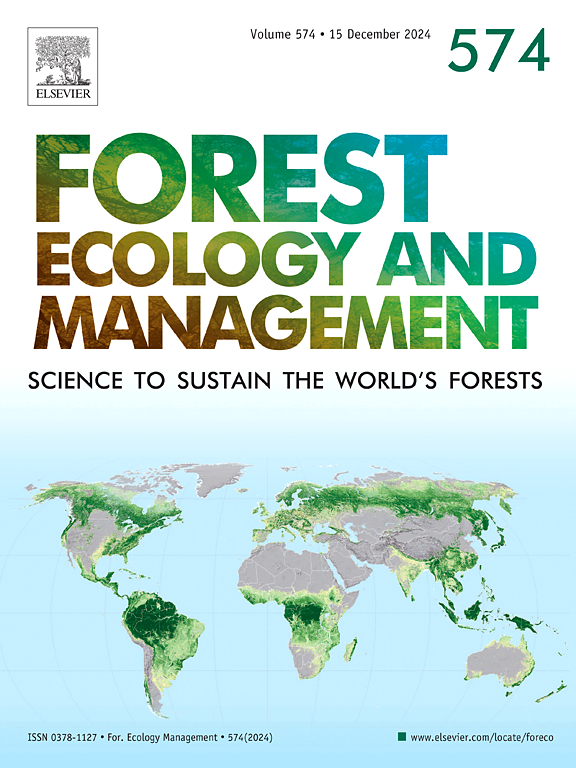Arbuscular mycorrhizal fungi inoculum from degraded forest soils promotes seedling growth of a keystone mountain tree used for restoration
IF 3.7
2区 农林科学
Q1 FORESTRY
引用次数: 0
Abstract
Polylepis forests represent one of the most endangered high mountain ecosystems in South America. Therefore, it is necessary to inform local nurseries of the best soil inoculum to grow healthy and strong P. australis seedlings for forest restoration purposes. Arbuscular mycorrhizal fungi (AMF) affect plant performance and plants respond differently to them. Previous studies show that the best AMF source is from non-degraded P. australis forests. However, inoculum from degraded areas has never been tested. The response of P. australis seedlings to inoculation with soils from four sites differing in livestock-associated forest degradation and the identification of root-colonizing of AMF species were evaluated. Natural soils inoculum was collected within the Sierras Grandes Mountain range in central Argentina and belongs to degraded grassland, degraded P. australis forest, intermediate degraded and non-degraded P. australis forests. The samples were described with regard to AMF diversity, soil characteristics, and mycorrhizal inoculum potential. The AMF species diversity and the soil infectivity were high in the degraded forest. Contrary to our expectations, the most advantageous AMF inoculum for promoting the shoot growth of P. australis seedlings in production facilities was sourced from degraded soils (forest and grassland). Seven AMF species were trapped by P. australis root plants and six of them were found in degraded forest soils. Only two AMF species, Septoglomus constrictum and Gigaspora sp., were found to be restricted to degraded forest. These data suggest that degraded forest soils provide the most effective inoculum for promoting sapling growth in a greenhouse setting.
来自退化森林土壤的丛枝菌根真菌接种物促进了一种用于恢复的关键性山地树木的幼苗生长
Polylepis 森林是南美洲最濒危的高山生态系统之一。因此,有必要让当地苗圃了解最佳的土壤接种体,以培育出健康强壮的欧鼠李幼苗,用于森林恢复。丛枝菌根真菌(AMF)会影响植物的性能,植物对它们的反应也不尽相同。以前的研究表明,最好的 AMF 来源于未退化的 P. australis 森林。然而,来自退化地区的接种体从未经过测试。本研究评估了 P. australis幼苗对接种来自四个不同地点的土壤的反应,这四个地点的森林退化程度与牲畜相关,本研究还鉴定了根部定殖的 AMF 物种。自然土壤接种物是在阿根廷中部的大山山脉采集的,分别属于退化草地、退化梭梭林、中间退化梭梭林和非退化梭梭林。对样本的 AMF 多样性、土壤特性和菌根接种体潜力进行了描述。在退化森林中,AMF 的物种多样性和土壤感染力都很高。与我们的预期相反,在生产设施中,对促进澳洲鹅掌楸幼苗嫩枝生长最有利的 AMF 接种体来自退化土壤(森林和草地)。有 7 种 AMF 被 P. australis 根系植物捕获,其中 6 种是在退化的森林土壤中发现的。只有两个 AMF 物种(Septoglomus constrictum 和 Gigaspora sp.)被发现仅限于退化森林。这些数据表明,在温室环境中,退化森林土壤为促进树苗生长提供了最有效的接种体。
本文章由计算机程序翻译,如有差异,请以英文原文为准。
求助全文
约1分钟内获得全文
求助全文
来源期刊

Forest Ecology and Management
农林科学-林学
CiteScore
7.50
自引率
10.80%
发文量
665
审稿时长
39 days
期刊介绍:
Forest Ecology and Management publishes scientific articles linking forest ecology with forest management, focusing on the application of biological, ecological and social knowledge to the management and conservation of plantations and natural forests. The scope of the journal includes all forest ecosystems of the world.
A peer-review process ensures the quality and international interest of the manuscripts accepted for publication. The journal encourages communication between scientists in disparate fields who share a common interest in ecology and forest management, bridging the gap between research workers and forest managers.
We encourage submission of papers that will have the strongest interest and value to the Journal''s international readership. Some key features of papers with strong interest include:
1. Clear connections between the ecology and management of forests;
2. Novel ideas or approaches to important challenges in forest ecology and management;
3. Studies that address a population of interest beyond the scale of single research sites, Three key points in the design of forest experiments, Forest Ecology and Management 255 (2008) 2022-2023);
4. Review Articles on timely, important topics. Authors are welcome to contact one of the editors to discuss the suitability of a potential review manuscript.
The Journal encourages proposals for special issues examining important areas of forest ecology and management. Potential guest editors should contact any of the Editors to begin discussions about topics, potential papers, and other details.
 求助内容:
求助内容: 应助结果提醒方式:
应助结果提醒方式:


